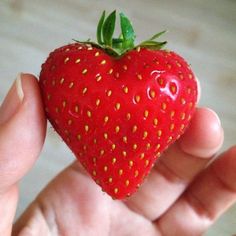The Tiny Strawberry is Packed with Vitamin C, Fiber, Antioxidants, and More
TEXARKANA, Ark. –\
The first clue that strawberries are good for you rest in their heart-shaped silhouette. These bright red jewels are packed with vitamins, fiber, and particularly high levels of antioxidants known as polyphenols. They are a sodium-free, fat-free, cholesterol-free, low-calorie food.
They are also among the top 20 fruits in antioxidant capacity and are a good source of manganese and potassium. Just one serving, or about eight strawberries, provides more vitamin C than an orange. Plus they provide only 49 calories, 12 carbs, and less than one gram of fat. As an added bonus, these little jewels are thought to protect your heart, increase HDL (good) cholesterol, lower your blood pressure, and guard against cancer.
This member of the rose family isn’t really a fruit or a berry but the enlarged receptacle of the flower. First cultivated in ancient Rome, strawberries are now the most popular berry fruit in the world. In provincial France, they were regarded as an aphrodisiac. These red gems may be good for your heart in more ways than one.
Let your nose be the guide for fresh strawberries. They should smell sweet and be bright red with fresh green caps. Look closely at the berries, making sure there are no signs of mold. One molded berry can spoil the batch. Choose medium-sized berries that are firm, plump, and deep red; once picked, they don’t ripen further.
Purchase your fresh strawberries last so they can be refrigerated quickly. Berries should not be left at room temperature for more than a few hours or you may begin seeing a browning effect due to the warm temperature. Use the strawberries as soon after purchase as possible to insure the best color, appearance and highest nutritional value.
Never wash strawberries or remove the caps until just before use. Removing the cap early can reduce the flavor, texture, and nutrient quality. Instead, store unwashed berries loosely covered with plastic wrap in the coldest part of your refrigerator for a maximum of three days. If held longer, a grey mold may develop.
For optimal storage, remove berries from their containers and arrange them no more than two berries deep in a shallow container or tray covered with waxed paper or plastic wrap.
When you are ready to use your strawberries, wash them by placing berries in a colander and rinse under cold running water. Allowing them to sit in water will result in a loss of color and flavor. Before serving or using your strawberries, remove the green cap with a plastic-tipped vegetable peeler or paring knife without removing any of the fruit.
Fresh grown local Arkansas strawberries are available at the Gateway Farmers Market at the corner of Jefferson and East 9th on Tuesdays, Thursdays or Saturdays, but may be gone soon. To know how many you need to purchase, here’s a simple guide: 1 basket equals 1 pint; 1 pint equals about 3 1/4 cups whole berries, 2 1/4 cups sliced or 1 2/3 cups pureed berries; 1 pint of strawberries also equals about 12 very large stemmed berries to about 36 smaller berries.
For more information about strawberries including recipes, contact the Miller County Extension Office, 870-779-3609 or visit us in room 215 at the Miller County Courthouse. We're online at chadley@uada.edu, on Facebook at UAEXMillerCountyFCS/CarlaHaleyHadley, on Twitter @MillerCountyFCS or on the web at uaex.uada.edu/Miller.
I love this easy Strawberry, Kiwi and Spinach Salad. It can easily be carried to potlucks and assembled there and makes a beautiful presentation.
Strawberry, Kiwi and Spinach Salad
3 tablespoons fat-free raspberry vinaigrette dressing
4 cups spinach, stems removed, rinsed and torn into bite-sized pieces
1/4 cup candied pecans, chopped
4 strawberries, quartered
1 kiwi, peeled and sliced
Combine spinach, pecans, strawberries and kiwi in a salad bowl. Toss with raspberry dressing and top with candied pecans. Serve immediately.
By Carla Haley-Hadley
County Extension Agent - FCS
The Cooperative Extension Service
U of A System Division of Agriculture
Media Contact: Carla Haley-Hadley
County Extension Agent - FCS
U of A Division of Agriculture
Cooperative Extension Service
400 Laurel Street, Suite 215 Texarkana AR 71854
(870) 779-3609
chaley@uada.edu
Related Links
The Arkansas Cooperative Extension Service is an equal opportunity institution. If
you require a reasonable accommodation to participate or need materials in another
format, please contact your County Extension office (or other appropriate office)
as soon as possible. Dial 711 for Arkansas Relay.
Pursuant to 7 CFR § 15.3, the University of Arkansas System Division of Agriculture
offers all its Extension and Research programs and services (including employment)
without regard to race, color, sex, national origin, religion, age, disability, marital
or veteran status, genetic information, sexual preference, pregnancy or any other
legally protected status, and is an equal opportunity institution.
